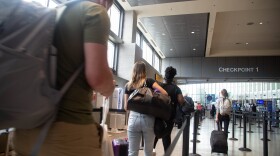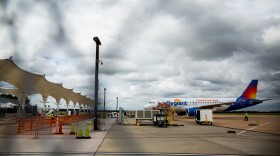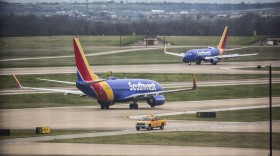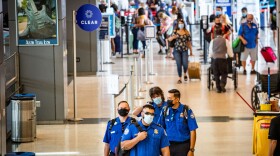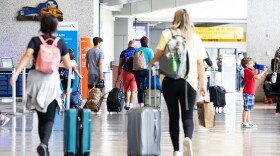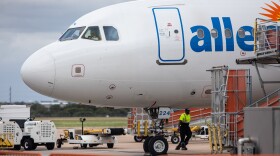As Austin-Bergstrom International Airport smashes all-time passenger records, city officials who run the airport are planning to squeeze even more flights through the Barbara Jordan Terminal's 34 gates.
"We're pushing capacity through the gates we have at a level that is beyond normal airport standards," ABIA's Interim Chief Planning and Development Officer Tracy Thompson told commissioners who oversee the city-owned airport Tuesday.
May was the first time more than 2 million passengers traveled through ABIA in a single month. That topped all-time records set in March and April.
Since then, airlines have added more flights.
In June alone, Air Canada started twice-daily flights to Toronto and began nonstop service to Vancouver. American Airlines began service to Asheville, North Carolina; Bozeman, Montana; San Diego, California; Cozumel, Mexico; and Montego Bay, Jamaica. And Southwest kicked off Saturday service to Cozumel.
ABIA now has flights to 93 nonstop destinations with 266 daily departures.
The next big ribbon-cutting at ABIA will be in October when Spirit Airlines starts a new daily service to Monterrey International Airport.

Preliminary estimates forecast the number of seats on flights out of Austin will keep growing through the year, culminating in a 45% increase over 2019 levels in November and a whopping 47% gain in December.
Airport officials use 2019 as a benchmark because it was the busiest year on record, with 17.3 million travelers. ABIA expects 22 million people to arrive or depart through the airport this year.
Meanwhile, airport staff are trying to drum up even more business overseas.
"I'm at London Heathrow meeting with international carriers here, ensuring that what we've got we can retain, and working on some longer-term international opportunities for Austin," ABIA assistant director Jamy Kazanoff told airport commissioners this week.
ABIA still has an incentive program to lure international flights to Austin by offering airlines fee waivers and help with marketing. An incentive program for domestic flights has been curtailed, Kazanoff said.
"It's still in the [Aviation] Department's best interest to continue to vie for these prized international routes," Kazanoff said. "Incentives are part of it." She pointed to San Antonio's new $3 million war chest to attract more nonstop routes.
London Heathrow — where Kazanoff was visiting — is among a handful of overseas airports that moved to limit travel in response to crippling staffing shortages. Heathrow, the UK's largest airport, will cap daily passenger volumes at 100,000.
ABIA's lack of workers has led to sometimes notoriously long lines, prompting officials to recommend people show up two and a half hours before boarding, which is usually at least three hours before departure. But ABIA has no plans to restrict flights or passengers in response to a lack of workers.

"Airlines are responsible for their operations and it remains unprecedented for [ABIA] to impose a daily passenger or flight cap like some of the airports in Europe in the UK have done recently," airport spokesperson Sam Haynes said in an email.
The practice of capping daily flights or passengers is uncommon in the United States in part because airport worker shortages aren't as severe as in Europe, according to industry analyst Henry Harteveldt at Atmosphere Research.
"I've not heard of U.S. airports restricting flights because of staffing issues," Harteveldt said.
He said the Transportation Security Administration appears to have done better at hiring and retaining security officers than European airports like Amsterdam's Schiphol, which is limiting daily passengers to 67,500 this month.
The TSA sent 61 temporary officers from its National Deployment Force to ABIA through the summer to try and keep all 17 screening lanes open at the busiest times of day, which are usually before 8 a.m.
But short-staffing among airlines is already forcing some reductions in service at ABIA.
Allegiant, which operates out of ABIA's privately-run South Terminal, will stop flights in August to Amarillo, Texas; Albuquerque, New Mexico; Springfield, Missouri; Tulsa, Oklahoma; Eglin Air Force Base, Florida; and Bentonville, Arizona because of staffing problems. JetBlue is suspending flights to Newark, New Jersey; Fort Lauderdale, Florida; and Los Angeles for the same reason.
The airport itself has struggled to fill positions. Aviation Department staff reported a $2.7 million savings in ABIA's operations budget since October, mainly from having so many job vacancies.
Airport officials are pushing forward with a $4 billion airport expansion that includes a new concourse connected to the Barbara Jordan Terminal by an underground pedestrian tunnel.

The new concourse, expected by 2027, would have at least 10 gates and space to construct as many as 40. But the project is contingent upon the city being able to use eminent domain to evict the operator of the South Terminal.
In the shorter-term, airport officials are implementing other capacity increases like upgrading the baggage handling system to be faster and more reliable, working with the TSA to install high-tech screening machines that speed up checkpoint lines and planning an "infill project" to increase floor space on the crowded departures level.
"I have to believe that as long as Austin's economy continues to be strong, that the airport will continue to see airlines continue to add flights as business conditions and operational factors allow them to do so," Harteveldt said.









